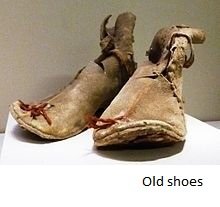Do you know about "Shoes History"
Hi guys ......Every go to school or to our office must wear shoes. In addition to protect the feet, shoes also make our appearance becomes more beautiful, but shoe was also kept a long and interesting history.
Historians estimate shoes were first made in ice ages or five million years ago and made from animal skins. Large numbers of primitive shoes have been found in the interior of Missouri, USA and are thought to date from 8000 BC (BC).
Other shoes have also been found in the mountains of France and originated from 3300 BC. Apart from animal skin there are also shoes made of grass or shrubs to protect the feet from the hot sun or cold temperatures. In addition to Missouri America, also found footwear derived from ancient Egyptian civilization, Viking, and ancient China.
History of the Origin of Shoes in the World
Once found a footwear that comes from Ancient Egypt and has a very beautiful picture. The footwear belongs to the King of Egypt. Footwear was then used to show social status.
Ancient Greeks also have footwear that greatly support their activities. His shoes have many ropes tied around the calf. The ancient Roman soldiers also have very distinctive shoes and are called sandalwood. When the Roman soldiers return from war and win, sandalwood will be given spikes that come from bronze, silver and even gold.
FOOTWEAR, whatever its name, shape, or model, has become so attached to everyone's feet. However, the familiarity of the foot with its wrapping was not easily experienced by many before 1882. Exactly when Jan Ernst Matzeliger, a worker in a shoe factory in America, invented a shoemaker. With the discovery of other shoemaking machines, began mass production of shoes, so that the price becomes affordable. People no longer need to make their own or bother ordering the cobblers around.
However, to arrive at that stage, the shoes have a very long journey. Thousands of years ago, raw animal skin was chosen for the wrapping of the human body and feet.
When the cold area of the wrapper is shoe-shaped, people in hot areas prefer sandals. The ancient Egyptians in 3700 BC for example, had been wearing sandals from plant fibers or animal skins.
The basic ingredients depend on the available material and the natural conditions. Wooden shoe for example, is very popular in the forested continent of Europe. While klompen wood (a kind of "shoes" clogs) are found in warm weather countries such as the Middle East, India and Japan. When moccasins (shoes made from a piece of material so that there is no seam between the soles with the top of the shoe) from the bark of Scandinavian footwear, the straw sandals and cloth shoes can be found adorn the feet of Korean and Chinese society. Especially for people in very cold weather areas, boots are widely used. Tibetans, Bhutanese, and Nepalis around the Himalayas, for example, are very familiar with yak boots.
Footwear was not always considered important, especially by the people of the region much exposed to the sun. On the frescoes of ancient Egypt, only kings and priests wearing footwear - they were sandals - made of braided weeds, or leather sandals like those made of braided weeds, or leather slippers as Tutankhamen wore , one of the Egyptian pharaohs.
For ancient Greek soldiers, sandals even have a very special function. They only wear one on the left leg. During a one-on-one fight, because the shield is taken with the left hand, the left foot is always ready to go forward, if necessary kick the crotch of the opponent. Well, a kick with sandals would have been better.

Congratulations @radithood! You have completed some achievement on Steemit and have been rewarded with new badge(s) :
Click on any badge to view your own Board of Honor on SteemitBoard.
For more information about SteemitBoard, click here
If you no longer want to receive notifications, reply to this comment with the word
STOPThank you so much